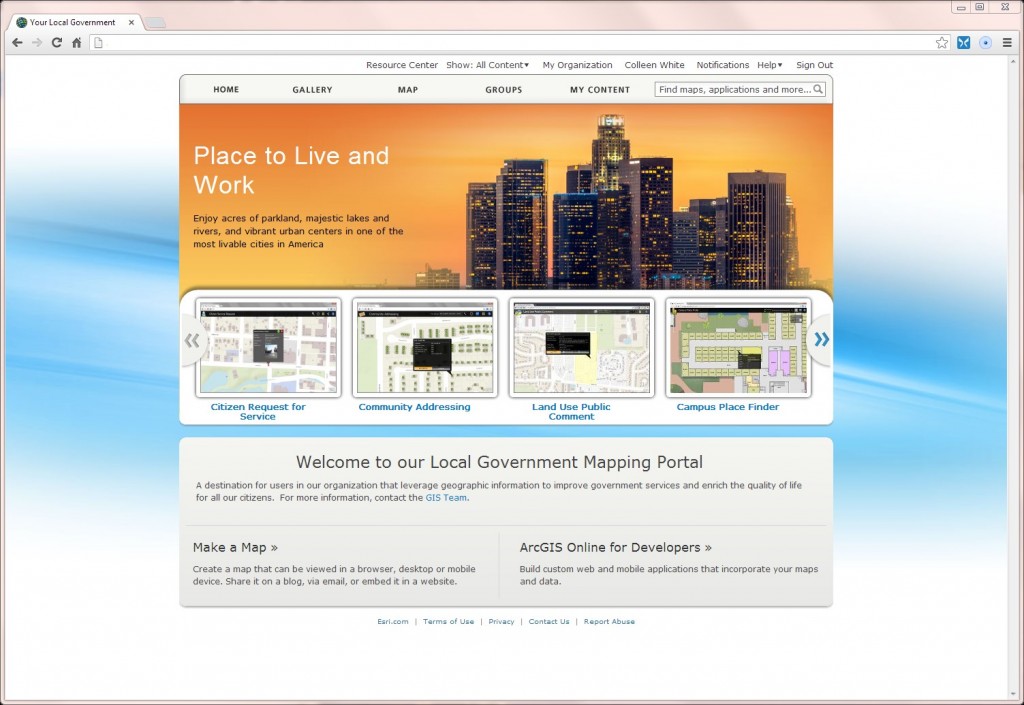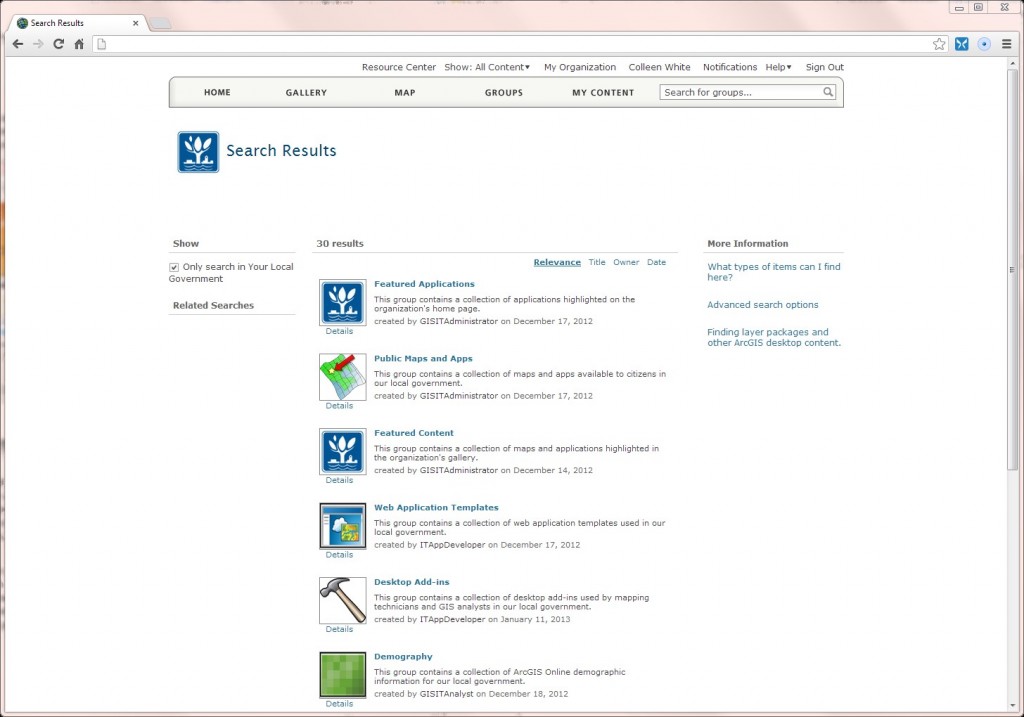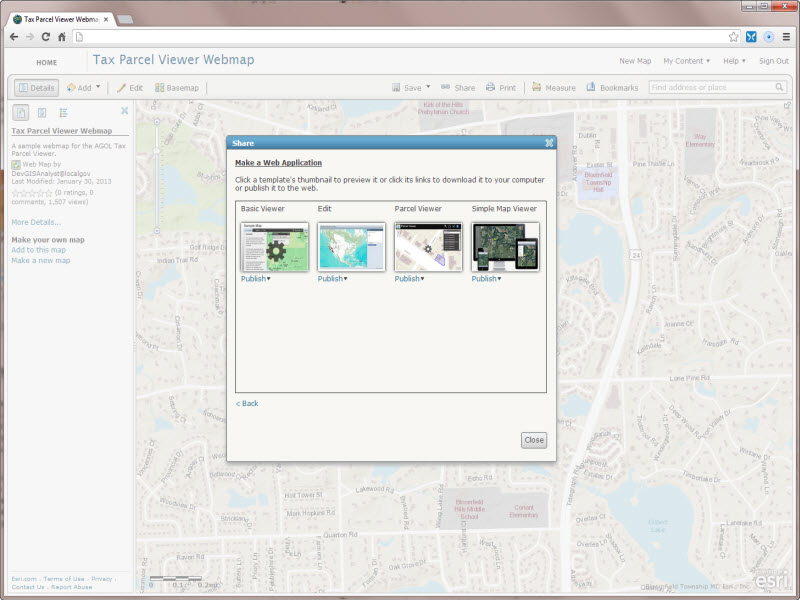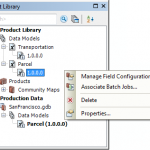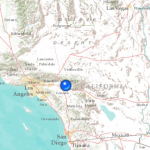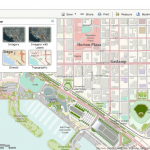Looking ahead to 2013, we want to share with you our plans for the ArcGIS for Local Government solution. In 2013, we’re excited to incorporate the functionality emerging across the entire ArcGIS platform into the ArcGIS for Local Government solution. Our focus in 2013 will be on ArcGIS Online and expanding the maps and apps in the solution offering. We want to make it easier for you to deploy ArcGIS Online in your organization, and enhance the solution offerings so you can continue to expand the value of GIS in your organization.
ArcGIS Online in Your Local Government
As Esri continues to increase functionality in the ArcGIS Online system, we want take a moment to talk about what that means for us as a local government community. First and foremost, we want to assure you that we are working towards enabling the ArcGIS for Local Government Solution (at all levels) within ArcGIS Online. What that means is, we will enrich the depth and capabilities of the solution so that the transition to ArcGIS Online will be seamless. At a technical level, it means we will be making changes to each web and mobile application, and the mapping services they use, so they can utilize ArcGIS Online as a platform for your GIS deployment.
Initially, we want to lay the foundation for the local government solution in ArcGIS Online. So the first offering we’ll provide is an ArcGIS Online Model Local Government Implementation. This model implementation will help you set up an ArcGIS Online subscription for your city, county or local authority. At the same time, the model organization will provide a pattern you can follow to leverage this cloud-based GIS platform to manage your content and deliver focused information products. The model local government implementation will show you how to:
- Configure ArcGIS Online as a mapping portal for your organization
- Create groups that support sharing and meet the functional needs of your organization
- Organize your map services and author relevant web maps and apps for users in your organization, and the citizens you serve
- Leverage the ArcGIS for Local Government solution to create useful information products in your organization
- Invite users into your organization to fill key roles in the online system
The initial release of the model organization will include Water Utilities, GIS / IT, Fire Service, Assessment / Taxation, Elections, Emergency Management and the Executive. In subsequent releases we’ll add other agencies and functions within a local government.
The model organization isn’t the only thing we’re doing to make it easier for you to leverage ArcGIS Online. We’re also developing a series of ArcGIS Online web application templates for our local government users. These application templates will be available natively in ArcGIS Online. They will allow users to author a web map and select a local government application when they share that map. We’re starting with an online version of the Tax Parcel Viewer.
Over time, we’ll continue to add web application templates to ArcGIS Online. These application templates will complement the applications we already provide in the solution. This means you’ll be able to maintain the applications you’ve already deployed with your authoritative content and leverage new ArcGIS Online applications in your organization.
This is just the beginning for the local government solution offering in the cloud. As we incrementally roll out new ArcGIS Online applications, you’ll be able to leverage the cloud solution to configure new maps and apps that were previously only available on your local computing infrastructure.
New Maps and Apps
So that was a quick overview of how ArcGIS Online will play a large role in the local government solution in 2013. And at the same time we’re providing new ArcGIS Online capabilities, we will also be enhancing the current portfolio of HTML5/JavaScript applications to make them more robust, configurable, and compatible with the ArcGIS Online platform. The enhancements include:
- Support for ArcGIS Online Hosted feature services
- Configurable Locators (locally hosted or from the newly launched geocode.arcgis.com)
- Support for the latest JavaScript APIs
- Standard code base for common components like search, share, etc.
- Additional code documentation
In all, we’ll be updating approximately twelve ArcGIS for Local Government apps in our next release. In 2013, we will also be expanding the solution offering. Let’s take a closer look at a few of the maps and apps we have planned.
Law Enforcement:
Data Management – A series of editing maps and tools used to manage fundamental law enforcement data, integrate data from external business systems (CAD, Records, AVL, etc.), and share it with other law enforcement professionals.
Cell Phone Analysis – A series of maps and tools used to estimate the location of a suspect’s and/or victim’s cell phone at a given time(s) of the day.
Pre-Incident Site Surveys – A series of maps that support the collection and inspection of pre-incident information for at-risk sites (ex. schools) in a community. This will be a coordinated with the Pre-Fire Planning and Special Event Planning Maps.
Crime Mapping – A series of operational management and reporting maps used in ComStat, daily resource allocation, neighborhood policing, and public information activities.
Fire Service:
Pre-Fire Planning 2.0 – A series of maps that support the collection, maintenance and inspection of pre-fire or pre-incident data. This will be a major enhancement to the existing Pre-Fire Planning map and will be a coordinated with the Pre-Incident and Special Event Planning Maps.
Target Hazard Mapping – A series of tools used to assign hazard/risk ratings to buildings and properties and identify candidates for Pre-Fire Planning maps.
Hydrant Inspection – A series of maps that support the inspection and maintenance of hydrants for the fire service community.
Emergency Management:
Public Safety COP – The last release of the Flex-based Public Safety COP. The final release will leverage work done on the National Guard Patriot Viewer and include a series of new widgets for the EM community.
Emergency Services – An adaption of the current My Government Services application that provides citizens evacuation, hazard and shelter information during an emergency.
Economic Development:
Development Showcase – An application that allows local governments to showcase properties in their community that are available for development.
General Data Management:
Data Reviewer for Basemaps – A series of ArcGIS Data Reviewer batch jobs that help local governments improve the quality of fundamental layers used in basemaps.
Data Reviewer for Parcel Management – A series of ArcGIS Data Reviewer batch jobs that help local governments improve the quality of parcel information managed with the ArcGIS parcel management solution.
In summary, this is going to be an exciting year for the ArcGIS for Local Government community. Our releases will coincide with major releases of ArcGIS and each release will include newly developed maps and apps, updates to existing maps and apps, bug fixes reported by the community, and new ArcGIS Online functionality.
We’ll provide more details on each of these initiatives as we get closer to our actual release. Please continue to use the Forums to contact us for help, provide feedback, and share your experiences with others.
